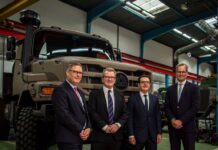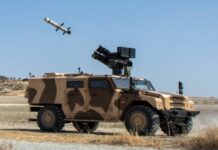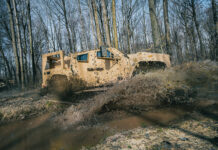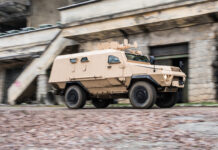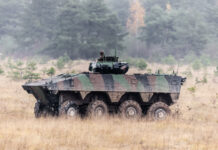Arquus has been developing a range of options to allow existing armoured fighting vehicles to be upgraded with hybrid propulsion systems. Recently, this work has begun to gain momentum, with the company proposing a range of upgrade paths targeted at different sectors of the vehicle market.
Arquus started working on alternative mobility solutions more than a decade ago. At that time, they developed a hybrid drive system for the Véhicule de l’Avant Blindé (VAB) armoured vehicle, replacing the Internal Combustion Engine (ICE) originally installed. The objective was having the autonomy for a three-day mission, but it was found that the state of the technology at the time meant a 25 tonne vehicle would be required, with 11 tonnes of that accounted for by the battery system, and even then, the mission requirement would be beyond its capabilities.
Work on non-ICE mobility solutions continued, and in 2018 Arquus unveiled the Scarabee vehicle at Eurosatory. The hybrid Scarabee represented Arquus’ solution to meet the French Army Véhicule Blindé d’Aide à l’Engagement (VBAE) requirement to replace the legacy Panhard Véhicule Blindé Léger (VBL) 4×4 protected patrol vehicle. In a reconnaissance mission, the ability to utilise electric drive to reduce vehicle noise signature offers substantial operational advantages.
This work on hybrid propulsion led to the then French defence minister, Florence Parly, to announce in September 2020, that Arquus would conduct a study with the DGA on a hybrid electric vehicle (HEV) solution for the Véhicule Blindé Multi-Rôles (VBMR) Griffon, with the intention to develop a functional hybrid propulsion system for the vehicle. Successful implementation of an HEV solution for the Griffon would also provide the basis for Véhicule Blindé de Combat d’Infanterie (VBCI) and Engin Blindé de Reconnaissance et de Combat (EBRC) Jaguar vehicles to have hybrid solutions as well. Armoured vehicles in this category have extremely high electrical power demands, something that HEV solutions are better-suited to meeting than Battery Electric Vehicles (BEVs).

The HEV option to power armoured vehicles gained serious momentum once the Griffon hybrid study commenced, especially since improvements in battery and associated technologies promised ongoing performance growth. At a technical level, thought was given to the implications of HEV solutions for tanks. In the case of France, HEVs could have applications in both current and future tank programmes, but it is a matter of timing and convincing the user that an HEV solution is practical and offers performance advantages.
In the case of the French Army’s Leclerc main battle tank, 200 vehicles are being upgraded under the Leclerc XLR programme, with all tanks to be delivered by 2029. From 2035 onwards, the tank needs of the French Army are due to be met by the Main Ground Combat System (MGCS), a collaborative programme with Germany. If, for whatever reason, MGCS is delayed, that would likely result in the service life of the Leclerc being extended further. In turn, this could lead the French Army and the DGA to consider further upgrades, with the engine being a likely candidate. The current Wärtsilä V8X 1,500 hp engine is said to be becoming difficult and expensive to support, with reliability and fuel consumption also being areas of concern, as the engine confronts obsolescence issues.

Next Steps
It should be stressed that an HEV solution for Leclerc is only being discussed, and is not at present a real programme. However, Arquus sees the HEV option as one possible path for future tank propulsion and as a valid upgrade solution. The problem is that at present it can be difficult to persuade end-users that HEV is the way forward. Equally, the other non-ICE mobility solution in the form of BEV electric solution is not practicable at this point due to weight, space constraints and performance limitations.
This led Arquus to consider another approach to tank engine requirements; their enthusiasm for hybrid solutions remained, but they also came to the conclusion that more modern ICE solutions could offer considerable performance advantages over current in-service systems. It was therefore decided to develop a range of tank engine upgrade proposals based on these new ICE solutions. They then developed a path that would allow the user to undertake a further upgrade to a hybrid solution if so desired. As such, there are three upgrade paths available:
- Upgrade with a modern, more efficient, lower-emission ICE;
- Upgrade from the modern ICE to hybrid electric drive;
- Opt for an HEV solution from the start.
Powerpack solutions would be geared towards two vehicle categories: heavier tanks with a combat weight of 60-70 tonnes, and lighter tanks or other armoured vehicles with a combat weight of 40-60 tonnes. In the lower of the two weight categories, the intention is to target export markets.
Central to these upgrades is a new range of engines from Volvo Penta such as the D13 and the D16, which were designed to offer high reliability, plus low fuel consumption and low emissions, while being compact enough for a wide range of vehicle installations. Another Volvo Penta engine, the D17, derived from the D16, is designed for Auxiliary Power Unit (APU) applications and this could also be offered as a part of the tank upgrade package. With these engines in a hybrid solution, the tank ICE engine can be switched off, but power would be provided to the tank’s systems while reducing the vehicle’s heat and acoustic signature, as well as decreasing fuel consumption.

Looking to wider industrial trends, Arquus’ parent company Volvo Group is aiming to move beyond conventional ICEs in their truck business, since they believe the future will be based on BEV trucks. Volvo wanted to secure a strong position in this area before governments mandate BEVs, so it invested heavily in BEV technologies. BEV trucks are set to make up some 35% of the Volvo range by 2030, increasing to 80% by 2040. Volvo Group has strong incentives to take a lead in producing this technology, as along with Volvo Trucks, the group owns Renault Trucks and Mack, while also having a 45% stake in Dongfeng Commercial Vehicles, together representing a substantial segment of the logistics vehicle market. Volvo Group’s investment in BEVs and other technologies is also available to Arquus, allowing them to reap the benefits of the group’s investments in ICE, HEV, and BEV solutions.
Developing a tank powerpack solution is no easy business, hence many in-service tanks find their performance compromised by their existing engine. As such, the relatively flexible upgrade path presented by Arquus provides a range of options which would allow a user to flexibly upgrade sections of their vehicle fleet as required. As emissions targets loom ever larger in the political landscape, and with the existence of viable hybrid alternatives presenting operational advantages, even militaries are likely to begin feeling the pressure to reduce their emissions.
David Saw





